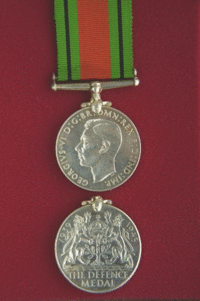Defence Medal
Under the terms of this last condition, Canadians serving for one year in Newfoundland were eligible and persons serving for six months in Hong Kong were also eligible. The qualifying period in mine and bomb disposal was three months. Canadians serving in West Africa, Palestine and India, other than operational air crew, qualified for this medal. Those awarded the George Cross (GC) or George Medal (GM) for civil defence received this medal. Home Guard and others in Britain qualified for this medal.
Description
A circular, silver medal (80% pure), 1.42 inches in diameter. The British issue medals were made of cupro-nickel.
Obverse
The obverse shows the bareheaded coinage effigy of King George VI, facing left, and the legend: GEORGIVS VI D: BR: OMN: REX F: D: IND: IMP:
Reverse
On the reverse, the Royal Crown rests on the stump of an oak tree, flanked by a lion and a lioness. At the top left is the date 1939, and at the top right, the date 1945. In exergue, though not ruled off, is the wording: THE DEFENCE/MEDAL.
Ribbon
The light green ribbon is 1.25 inches wide with a central stripe of orange and a narrow black stripe in the middle of each green stripe. The orange represents the enemy attacks on the green land of England while the black represents the black-outs.
Mounting
Mounting includes a plain, straight, non-swiveling suspender with a single-toed claw.
Dates
The Defence Medal was a Second World War medal which was established on 16 August 1945.
Naming
The medals were not named.
